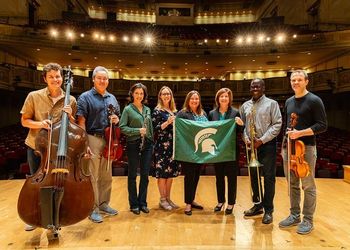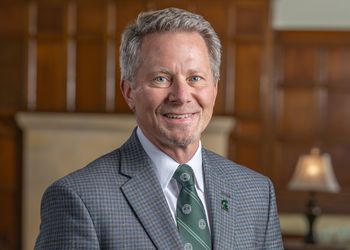Cover Story: What It Means To Be A Land-Grant University

As we celebrate the university’s Sesquicentennial, it is timely to review the principles that shaped MSU’s founding and still provide guidance today.
Entering campus from the east or west visitors are reminded that Michigan State University is “The Nation’s Pioneer Land Grant College.” The University’s mission statement reinforces the importance of its land grant identity, referencing the University’s land grant status six times in that brief document. President Simon reaffirmed the importance of Michigan State’s land grant ideals in her Founder’s Day address on the occasion of her inauguration as President when she advocated, “Michigan State University must lead Michigan, our nation, and the world in achieving a redefinition – a revitalization – of the covenant we share with society.”
But what is a land grant institution? What are land grant ideals and why do we embrace them? Are they as true today as they were in 1855?
Imagine for a moment that it is 1849; the year in which Crazy Horse was born and Dolly Madison died. Imagine that you live in what is now East Lansing, Michigan. You actually live in Meridian Township, population 367. You are likely a farmer as more than 60 percent of Michigan residents are farmers in 1849. The likelihood that you were educated beyond the twelfth grade is less than two percent.
In 1849, a college education is almost exclusively a privilege of the wealthy. Those who do attend college typically study theology, the arts and letters, medicine, and the law. In 1849, a college education would have been of little practical value to most Americans, regardless of access, because colleges did not teach agriculture, engineering, and other practical disciplines.
What is a Land Grant Institution?
Against this backdrop, Justin Morrill, a Vermont congressman, introduced a bill which would permanently transform higher education. The Morrill Act, signed into law on July 2, 1862 by Abraham Lincoln, provided to each state in the Union a grant of 30,000 acres of federal land for each senator and representative then in congress. Michigan, with six congressmen and two senators, received roughly 240,000 acres.
The state sold this land, using the proceeds to support a college where, according to the Morrill Act:
“The leading object shall be, without excluding other scientific and classical studies, and including military tactics, to teach such branches of learning as are related to agriculture and the mechanic arts…in order to promote the liberal and practical education of the industrial classes in the several pursuits and professions in life.”
The idea of using federal land grants to fund higher education was not unique. In fact, the University of Michigan received several federal land grants upon its founding earlier in the 19th century. Thus, it was not the federal grant of land that made the Morrill Act extraordinary.
Rather, the Morrill Act was extraordinary because, through federal grants of land, it ignited a revolution in higher education through two radical ideas. These two ideas were, first, to “promote … liberal and practical education” and, second, to provide this education to “the industrial classes.”
A curriculum that is both “liberal and practical” recognizes the importance of the liberal arts. But it adds to that curriculum the practical knowledge critical to the working classes of the time; disciplines like agriculture, engineering, mathematics, and biology. In addition to teaching these practical disciplines, land grant colleges first recognized that they were disciplines worthy of scholarly research. The Morrill Act legitimized, and funded, a “liberal and practical” curriculum and research agenda.
The Morrill Act then opened the doors of this refocused university to “the industrial classes;” the working men (and, later, women) of Michigan. In 1862, when the Morrill Act was passed, most of these men were farmers. Never again would a college education be an exclusive privilege of the wealthy. Never again would higher education focus almost exclusively on the liberal arts and sciences. Instead, land grant colleges helped society solve practical problems and enrolled working class students in a practical curriculum.
In her address on the occasion of the University’s sesquicentennial, President Lou Anna K. Simon emphasized the importance of this land grant mission and reflected on Michigan State’s implementation of these land grant ideals at its founding in 1855, a full seven years before the passage of the Morrill Act:
“We gather today to observe and to celebrate the birth of a revolution—a revolution born 150 years ago in Michigan that has influenced the development of higher education across our nation and around the world. As the first land-grant university—the pioneer land-grant university—our university spearheaded a movement that led to the development of a totally new educational tradition.
“I’m not speaking here of the establishment of agricultural colleges, which many people mistakenly believe the ‘land-grant tradition’ to mean. I’m speaking of a visionary idea of higher education that called for embracing practical knowledge, as well as traditional scientific and classical studies, and giving all—not just those preparing themselves for a few traditional professions—an equal opportunity to become citizen leaders and to shape a new, wider range of knowledge required by our rapidly growing nation. “
This vision—our pioneering vision of a university—was a bold new experiment that became the model for the land-grant legislation first sponsored in 1857 by then Congressman Justin Morrill of Vermont, who, after a five-year struggle, succeeded in establishing the Act of Congress known as the Morrill Act, which Abraham Lincoln signed into law in 1862.
Michigan State Leads the Land Grant Movement
How was it that Michigan State University led the land grant movement? Take yourself back, again, to 1849. The Executive Committee of the Michigan State Agricultural Society has commissioned Bela Hubbard, a Detroit naturalist, to develop a plan that will bring higher education to Michigan farmers. Hubbard describes it as an “enlightened liberal education.”
He explains: “A liberal education is essential to farming because all agricultural discovery depends not only on familiarity with farm practice, nor on a willingness to experiment, but also on a knowledge of those fundamental laws of science upon which every improvement is based.
“The college must teach agriculture and all of the natural sciences; it should teach mathematics, bookkeeping, engineering, architecture, and landscape gardening. Nor should the claims of literature and the fine arts be wholly neglected, as tending to polish the mind and manners, refine the taste, and add greater luster and dignity to life.”
This concept of an “enlightened liberal education”—extending beyond the traditional curriculum and taught to students of the working classes—was revolutionary. According to historian Madison Kuhn, at that time, “There were nearly 200 colleges and universities in the United States, yet none taught agriculture and few offered more than rudimentary chemistry or biology.”
The Michigan Legislature responded by requesting a land grant from the federal government of 350,000 acres, the sale of which would fund an agricultural school, but Congress ignored the request. Undaunted, Michigan’s leaders again took up the cause of an agricultural college at Michigan’s constitutional convention of 1850. The 1850 Michigan Constitution included a provision requiring that the state legislature establish an agricultural school.
Thus, on February 12, 1855 Governor Kinsley S. Bingham signed into law a bill authorizing the creation of a state agricultural school to be built within ten miles of Lansing. Consistent with Hubbard’s concept of an “enlightened liberal education,” the act provided that: “The course of instruction in said college shall include the following branches of education, viz: an English and scientific course, natural philosophy, chemistry, botany, animal and vegetable anatomy and physiology, geology, mineralogy, meteorology, entomology, veterinary art, mensuration, leveling and political economy, with bookkeeping and the mechanic arts which are directly connected with agriculture….”
Thus, the Agricultural College of the State of Michigan was born. Two years later, on May 14, 1857, the college opened its doors to students. On May 13, 1857, at the college’s dedication ceremony, President Williams stated:
“Here in the wilderness a new citadel of democracy has been built. Formerly, higher education has been provided only for the favored few, and seven-eights of the race, on whose toil all subsist, have been deemed unworthy of mental cultivation. Now, in this new institution, the State of Michigan is prepared to take the student directly from the common school, yet carry him farther than the university in the application of modern science to the practical business of life.”
So, in 1857, in a small clearing on the outskirts of Lansing, Michigan 63 students and their five professors set about to start a revolution; a revolution that five years later would culminate in the Morrill Act.
150 Years Fulfilling the Land Grant Mission
Since 1857, Michigan State University has been leading the nation in the growth and development of research, teaching, and outreach grounded in the land grant ideals. In the early years of the University, William J. Beal’s research on the cross-fertilization of corn led to the development of hybrid corn, increasing a corn crop’s yield by as much as 50 percent.
In 1876, Michigan State sent professors out to Michigan’s rural communities to conduct Farmer’s Institutes. At these institutes MSU professors taught local farmers how to improve crop quality and yield through scientific methods researched on campus.[1] In the spirit of the land grant tradition, Farmer’s Institutes brought research-based, practical knowledge to the working classes. These institutes were precursors to the agricultural experiment stations established by Congress in 1887.
In the late 1880s, Robert C. Kedzie’s research facilitated the development of the sugar beet industry in Michigan. Kedzie, an active public health advocate, also recognized the danger associated with the use of arsenic in wallpaper. His lobbying efforts led to legislation prohibiting the use of arsenic in wallpaper.
In 1906 President Jonathon Snyder began appointing extension agents to disseminate the fruits of the University’s research across Michigan. Two years later, in 1908, President Theodore Roosevelt created the County Life Commission, chaired by Liberty Hyde Bailey (MSU Class of 1892). The commission generated a report that resulted in passage of the Smith-Lever Act of 1914 establishing the Cooperative Extension Service. The Smith-Lever Act was a modification of legislation introduced years earlier that had been drafted by Kenyon Butterfield (MSU Class of 1891).
More recently, in 1956, Michigan State broadened its land grant mission to issues facing the world community when it became the first major U.S. university to establish a dean for international programs. This early emphasis on international affairs translates today into a university in which more than 1000 faculty are involved in international research, teaching, and service projects and almost 2000 students annually participate in study abroad programs; making Michigan State’s program one of the top study abroad programs in the nation.
Closer to home, Michigan State’s Diagnostic Center for Population and Animal Health is one of the world’s finest veterinary pathology laboratories. The center works with Michigan’s agricultural community to detect diseases affecting Michigan farm animals. The center played a leading role in identifying the effects of PBB on Michigan cattle and, more recently has led Michigan’s efforts to identify birds affected by the West Nile Virus. It handles over 160,000 cases involving nearly a million tests each year.
The Land Grant University for the 21st Century
In its sesquicentennial year, Michigan State is prepared to fulfill its land grant mission for another 150 years. It is a university focused on the values of quality, inclusiveness, and connectivity; reframing the values of 1855 to address the challenges of today. The land grant college of 1855 focused on farming in an agrarian economy. The land grant university of 2005 is a university engaged with the myriad problems of society both here in Michigan and around the world. President Simon refers to this as a new covenant that Michigan State must establish with the people of Michigan and the world.
As President Simon explains, “The land-grant idea was revolutionary because it extended the borders of the campus to every community in the state. Today it is equally revolutionary because it extends the borders of our campus to every continent on the planet.”
William R. Beekman, '89, is senior consultant to MSU's vice president for finance and operations and MSU's vice president for academic affairs and is an assistant professor in MSU’s Dept. of Family Practice. He currently serves as chairperson of the MSU Alumni Association's National Alumni Board.



